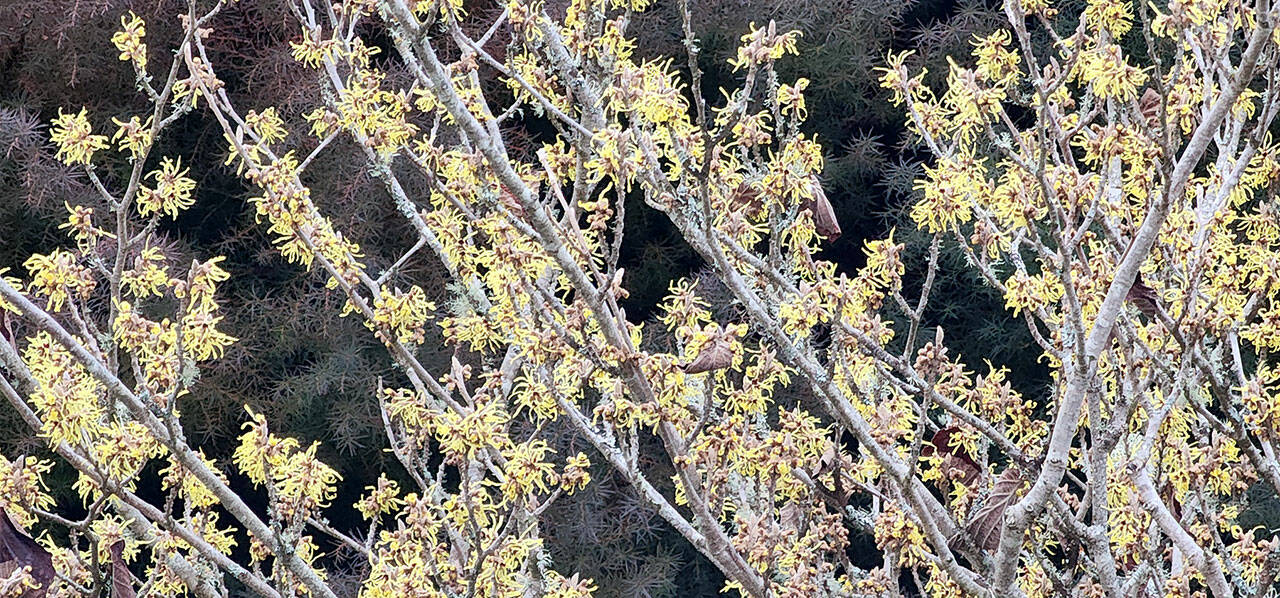AS PROMISED, HERE is my warning and worry about our way too warm seasonal weather of late!
Witch hazel (the must have, spider like blooming winter shrub with gorgeous fall foliage colors) is already in bloom, although it’s flower isn’t due yet for another month.
I saw daffodils, iris and tulips already poking up out of the ground with flower stalks showing.
A beautiful little deciduous sycamore tree, unbeatable in it’s burning ember autumn display, whose leaf buds are already plump. The flower tassels are out and developed on alder trees, while I admired pussywillows with their lovely large white blooms.
Even at my own house, 994 feet above the shimmering Straits of Juan de Fuca, carpenter ants are coming out of dormancy and scurrying across the wood floor. And the weeds, an onslaught of exponentially growing intrusive invaders, are fully launched against your yard as well as the entire neighborhood.
So with the snowpack decreasing in the Olympics while rain falls upon us in record-breaking temperatures, what should the gardener do? Plenty!
First let me address a few concerns that have manifested as I drove around last week.
Premature emergence
I see your spring bulbs prematurely emerging, and this will become ever-increasing as the unseasonably warm temperatures continue to visit us. And unfortunately, this couples with human nature’s very strong tendency to not plant bulbs deep enough (measure depth from top of bulb), which only causes them to emerge even earlier.
Well, happy New Year, lucky you, because along with this trend are thousands, millions, even billions of weed seeds taking advantage of warm, conditions — germinating faster than aphids multiply on your dahlias. But in one fell swoop (actually the unload of a dump truck), your problems are over and your inherently poor, yellow soil layer becomes greatly enhanced for the super bonus round.
Here’s how it works: order a load of good, rich organic topsoil, or a load of nice brown-black, semi-decomposed mulch. Actually, you would be a wise horticulturist to order 5 yards of each, because that will only handle the task for the next few weeks.
If your bulbs are coming up early but not over 2 inches tall, cover them with an inch or two of topsoil and then an inch of mulch. If your bulbs are up much higher, spread a few inches of mulch around them with great care; don’t “plop” it on top of them.
First, cultivate carefully and add a good dose of lime at 60 pounds per 1,000 square feet and a bone meal/blood meal mix (50/50) at the same 60 pounds for 1,000 square feet.
Then, top dress your area with the soil or mulch.
Weeds everywhere? Same thing; cultivate fertilizer and lime, smother with topsoil. This time of year an inch or two of mulch or soil kills weeds at an astonishing 98 percent rate.
Rich topsoil
If every year during the winter, you employ this system of smothering as your weed control method, your rocky, sandy soil will turn into a deep, dark, rich bed of topsoil. Your landscaping will be virtually weed-free as the ever-growing mulch keeps moisture in all year, while washing your plants in a bath of nutrient abundant humic acids.
And guess what? The deeper your roots are below the surface and the more mulch is built up around your trees, shrubs, roses, perennials, vines and bushes (but not touching their canes or stems), the more consistent soil temperatures will mean they’ll react more slowly to abnormal heat or cold.
The warm temperatures we’ve been having also have me worried about old leaves on your grass or around magnificent perennials.
I cannot believe I see so many early spring perennials already breaking forth with new shoots.
Clean away all old deciduous tree, brown, moldy and rotting leaves. But do not clip back, rake up and cultivate around them. This will only stimulate their growth before the guaranteed hard freeze coming in the next two months.
Just remove non-invasively rotting, soft plant tissue from their crowns.
Keep grass short
Keep your grass cut short. I will soon remind you about cutting it too short, so fully indulge now and let the air and light shine down and perform a very valuable task of keeping the blades dry. By all means, over-seed your lawn if you need to.
And finally, get geared up for this season’s big projects and garden chores. Be on the lookout for the first bare root items and plant them immediately.
Gather up and order as many catalogs as possible.
Inventory, oil and repair all tools and equipment.
Winter, which lasts until March 20, has begun and the next 3 months can really make or break your ornamental yard.
And like all the plants in your yard — stay well all!
________
Andrew May is a freelance writer and ornamental horticulturist who dreams of having Clallam and Jefferson counties nationally recognized as “Flower Peninsula USA.” Send him questions c/o Peninsula Daily News, P.O. Box 1330, Port Angeles, WA 98362, or email news@peninsuladailynews.com (subject line: Andrew May).

